QNAP's TS-EC1279U-RP 12-bay Flagship Rackmount NAS Review
by Ganesh T S on April 29, 2013 4:30 PM EST- Posted in
- Enterprise
- Storage
- NAS
- QNAP
Multi-Client Performance - CIFS
We put the QNAP TS-EC1279U-RP through some IOMeter tests with a CIFS share being accessed from up to 25 VMs simultaneously. We configured the network links of the NAS in two ways. In the first configuration, two of the ports were link aggregated (and the other two teamed and configured as active backup). In the second configuration, all four links were link aggregated as a single 4 Gb link. The following graphs show the total available bandwidth and the average response time while being subject to different types of workloads through IOMeter. IOMeter also reports various other metrics of interest such as maximum response time, read and write IOPS, separate read and write bandwidth figures etc. Selected metrics from the evaluation of the ioSafe N2 are available here for the dual teaming case and here for the quad teaming case.
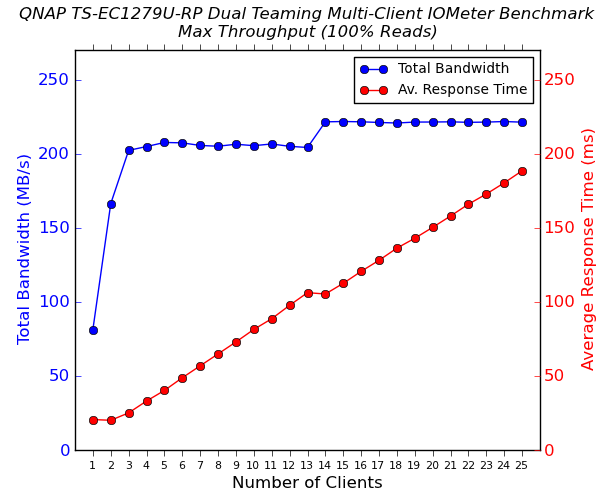
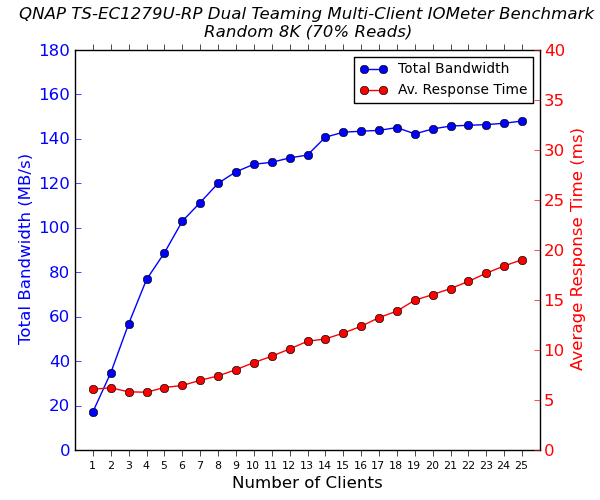
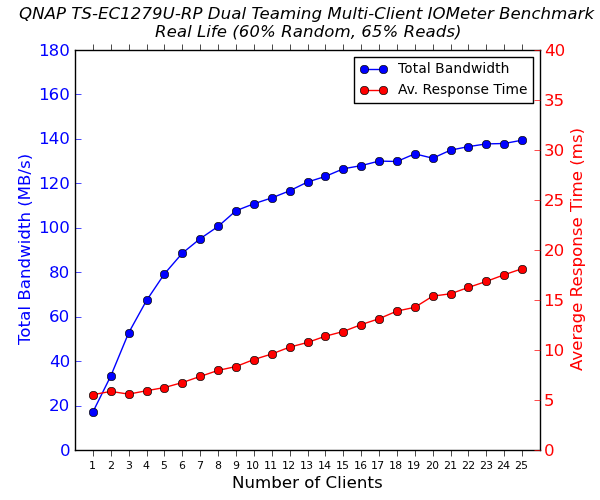
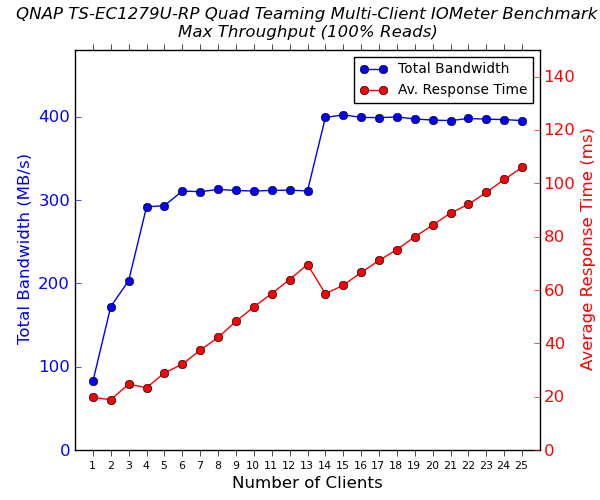
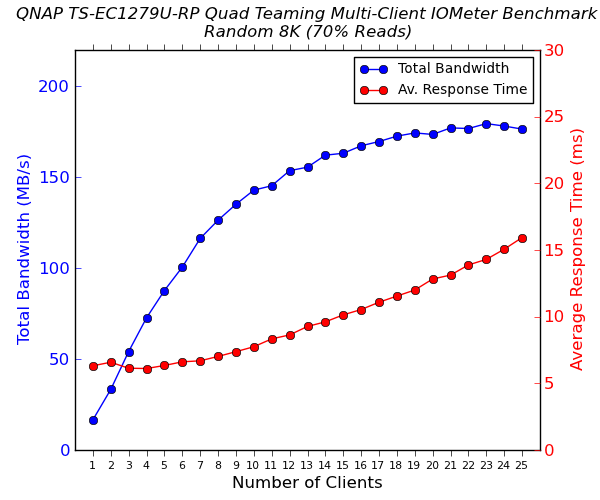
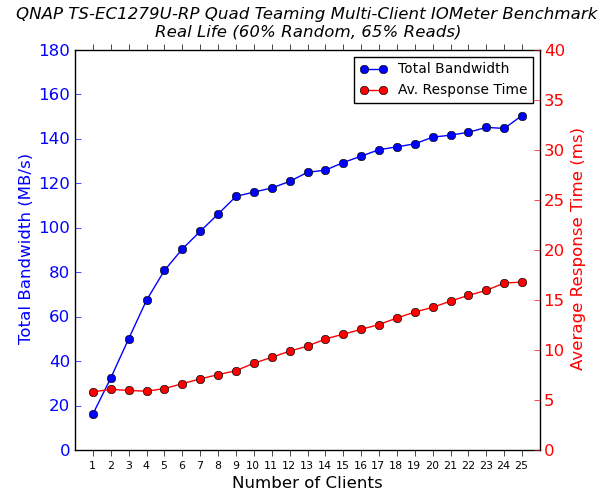
We don't have any comparison graphs for these because this is the first unit we are evaluating using SSDs (the 120 GB OCZ Vector units). The previous tower form factor NAS units were evaluated using the Western Digital 4TB RE disks. We haven't graphed the results from the sequential 50% read tests since the aggregate bandwidth figures put out by IOMeter seem implausible (even though the standalone read and write bandwidth figures seem to make sense).
Comparing the sequential 100% reads performance between the dual and quad teaming cases, we find that the performance is limited by the network links. In the other cases, we see that it might be possible to extract even more performance out of the unit by having more clients accessing the unit simultaneously.










23 Comments
View All Comments
Jeff7181 - Tuesday, April 30, 2013 - link
EMC, Hitachi and NetApp provide enterprise class NAS and SAN arrays. This, nor any, QNAP product is anywhere near that level.Walkeer - Thursday, May 9, 2013 - link
agreed, plus NAS is not really enterprise anyway since these is SANdavegraham - Tuesday, April 30, 2013 - link
Ganesh,having worked in the storage industry (and now working for an enterprise and carrier networking company doing data center architecture and design) QNAP, Drobo, et al. aren't names that carry any weight for enterprise-class storage. The systems I deal with (for example, EMC Symmetrix VMAX 40K) are considered "enterprise class" storage systems (99.999% uptime, SSD caching and tiering, finely tuned atomic memory and storage access, multiple active processing storage engines/directors, fibre channel/FCoE/iSCSI front ends, extensive API command/control sets, replication [local & remote], snapshotting/cloning, etc.). As Jeff7181 notes below, these stand alone in a class by themselves.
cheers,
D
Walkeer - Thursday, May 9, 2013 - link
agreed, this is a SOHO toy...jaziniho - Wednesday, May 1, 2013 - link
Unless this comes in a model with dual controllers (not just dual PSUs), then it's squarely in the SMB rather than enterprise space.Support for SAS as well as SATA disks would also be high on list of potential requirements for enterprise. With RAID rebuild times on large drives so long, you need disks with decent reliability to give you more confidence in making it through the rebuild.
aloginame - Saturday, May 11, 2013 - link
I agree with the fact that this QNAP is not really a "Enterprise" or "High-End" solution for NAS, however, I have to disagree when it is being compared to something like EMC Symmetrix VMAX 40K, for those are really SAN solutions and not NAS.golemite - Monday, April 29, 2013 - link
Hi Ganesh, any chance of getting reviews of lower end rackmount NAS systems like the Synology RS812/812+?ganeshts - Wednesday, May 1, 2013 - link
We have the Synology RS10613sx+ in the pipeline, but it costs approx. twice that of the TS-EC1279U-RP and caters to users who require more performance / features.mmayrand - Tuesday, April 30, 2013 - link
So, you spend $3500 for box plus 12 SSD (not free) and you get the 1/3 of the effective bandwidth of a single SSD plugged in a $300 PC. Is there a point to these NAS boxes?davegraham - Tuesday, April 30, 2013 - link
Mmayrand,the concept behind a NAS box is shareable storage across N-number of users in a SoHo or SMB environment. at that point, it makes more sense to have a common pool of storage that can be "protected" (remember, RAID is NOT backup) and utilized more efficiently, than a scattered or siloed collection of independent disk in a laptop or desktop.
it also is a basic requirement for most virtualization (the concept of shared storage) solutions to maintain high availability and portability for virtual machines within a cluster. As a standalone box, you're right, you can hit better performance #'s because you're just straddling a PCIe bus vs. ethernet. however, change the venue and you're looking at a more ideal solution.
D